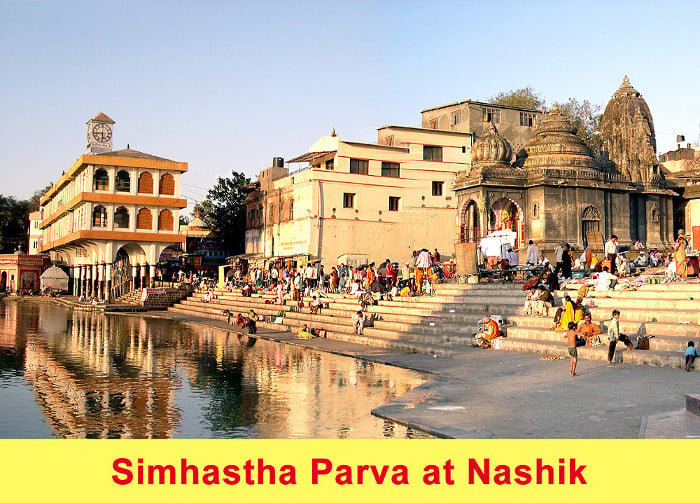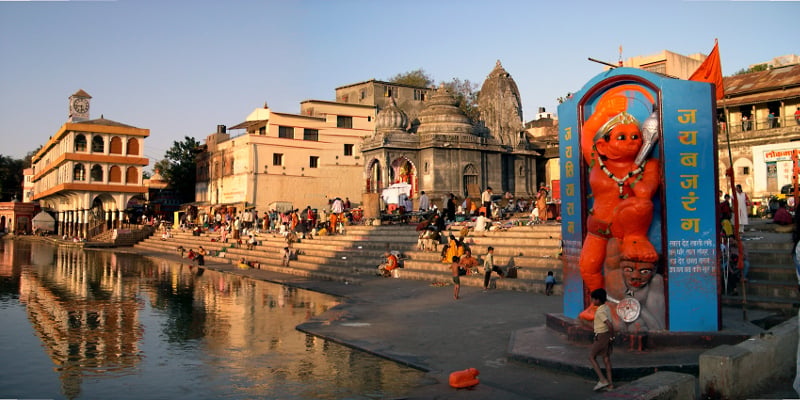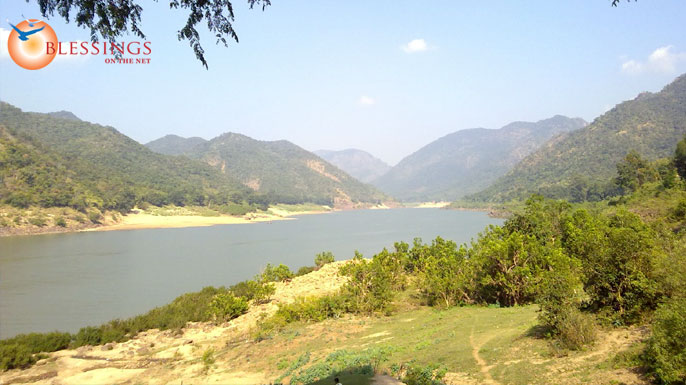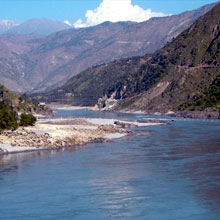14th JULY 2015 - 16th AUGUST 2016 DHWAJAROHAN START OF SIMHASTA KUMBH MELA TRYMBAKESHWAR - PANCHVATI NASIK


Kumbh Mela History
As per medieval Hindu theology, origin of Kumbha is found in most popular medieval puranas, the Bhagavata Purana. The Samudra manthan episode (Churning of the ocean of milk), is mentioned in the Bhagavata Purana, Vishnu Purana, the Mahabharata, and the Ramayana.
Churning the ocean of milk includes, the Mandara Mountain as the churning rod, and Vasuki, the king of serpents, became the rope for churning. The Devas had lost their strength by the curse of Durväsä Muni, and in order to regain it, they approached Lord Brahma and Lord Shiva. Both Lord Brahma and Lord Shiva directed all the demigods to Lord Vishnu and after praying to Lord Vishnu, they were instructed to churn the ocean of milk Ksheera Sagara (primordial ocean of milk) to receive amrita (the nectar of immortality).This is where Kumbh derives its name from the immortal Pot of Nectar, which the Demigods (Devtas) and Demons (Asuras) fought over.
They made a temporary agreement with their arch enemies, the Asuras, to work together with a promise of sharing the wealth equally thereafter. However, when the Kumbha (urn) containing the amrita appeared, a fight ensued. The Devas and Asuras fought in the sky for the pot of amrita for 12 days and 12 nights equivalent to 12 years for humans which is obviously unbelievable. During this chase, it is believed that few drops from the Kumbh fell at four places Allahabad, Haridwar, Ujjain, and Nasik. Thus Kumbh Mela is held every third year at one of the four places by rotation.
Nashik Kumbh Mela starts today - YouTube
www.youtube.com/watch?v=iieUjewwl5I4 hours ago - Uploaded by Abraham LauralynMajha Mahakumbh: Nashik: Dhwajarohan, Kumbhmela start from today. One of the ... The Nashik ...
Majha Mahakumbh: Nashik: Dhwajarohan, Kumbhmela start from today
Majha Mahakumbh: Nashik: Dhwajarohan, Kumbhmela start from today
Majha Mahakumbh: Kumbhmela schedule
All you want to know about Godavari Pushkaram

RELATED
NEW DELHI: Godavari 'Pushkaram' is a once in 12-year event dedicated to worshipping rivers in the two states of Andhra Pradesh and Telangana.
However, the Pushkaralu this year is special as it is Maha Pushkaralu which happens once in 144 years.
This year's Pushkaralu is considered auspicious from astronomical point of view.
The 'Pushakaram' is similar to the 'Kumbh Mela' performed alongside rivers elsewhere in the country.
Taking holy dip is the main ritual of the festival.
The two state governments have made elaborate arrangements for the convenience and security of thousands of pilgrims who will take holy dip.
However, the Pushkaralu this year is special as it is Maha Pushkaralu which happens once in 144 years.
This year's Pushkaralu is considered auspicious from astronomical point of view.
The 'Pushakaram' is similar to the 'Kumbh Mela' performed alongside rivers elsewhere in the country.
Taking holy dip is the main ritual of the festival.
The two state governments have made elaborate arrangements for the convenience and security of thousands of pilgrims who will take holy dip.
Main Bathing Dates for Nashik Kumbh Parva 2015
Uniqueness of ‘Simhastha Parva’ (Kumbha Mela) at Tryambakeshwar-Nashik
Bathing in the Godavari River is one special feature of ‘Simhastha Parva’. The Kumbha Mela will be held at the Tryambakeshwar-Nashik from 14 July 2015 to 25 September 2015, when not only crores of devotees, but Deities, Saints and thirty-three crore ‘Teerthas’ will also be present. All this is unique.
Benefits of bathing, religious rituals and
spiritual practice done during ‘Simhastha Parva’
- During the ‘Simhastha Parva’, people bathe in the Godavari River and worship Godavari (Ganga).
षष्ठिवर्षसहस्राणि भागिरथ्यावगाहनम् ।
सकृद्गोदावरीस्नानं सिंहस्थे च बृहस्पतौ ॥ – पद्मपुराण
सकृद्गोदावरीस्नानं सिंहस्थे च बृहस्पतौ ॥ – पद्मपुराण
Meaning : Merit of bathing once in the Godavari when planet ‘Guru’ is in the zodiac of is equal to that bathing in the BhagirathiRiver for 60,000 years
- Bathing, performing pitrutarpan, shraddha (Rites for deceased ancestors) etc. in Kushavarta Lake in Tryambakeshwar during ‘Simhastha Parva’ helps the ancestors progress to the next subtle-region.
- The important ‘Ghrutakumbhadan’ rite is performed only during ‘Simhastha Parva’. One who performs this rite with faith is liberated while still in the body (becomes jeevanmukta).
- Tonsuring is done on the banks of Godavari for self-purification and to liberate deceased ancestors.
Bathing, donating, chanting, performing rites during ‘Simhastha Parva’ begets infinite merits !
| SIMHASTHA PARVA (NASHIK KUMBHAMELA) – SHAHI SNAN | |
|---|---|
| 14.7.2015, Tuesday, Āshāḍha Vadya P.13 | Start of Simhastha Kumbha mela, Dhwajarohan, Ramkunda |
| 19.8.2015, Wednesday, Shrāvan Shu.P. 5 | Simhasthaparva Akhada Dhwaj-arohan, Sadhugram |
| 29.8.2015, Sunday, Shrāvan Shu.P. 15 | Simhasthaparva Pratham Pavitrasnan (First Shahi Snan) |
| 13.9.2015, Sunday, Shrāvan Vadya.P. 30 | Simhasthaparva Dwitiya (Pramukh) Pavitrasnan (Second Shahi Snan) Ravi – Chandra – Guru in Sinha Rashi |
| 18.9.2015, Friday, Bhādrapad Shu.P. 5 | Simhasthaparva Trutiya Pavitrasnan (Third Shahi Snan), Rushipanchami |
| SIMHASTHA PARVA (TRYAMBAKESHWAR KUMBHAMELA) – SHAHI SNAN | |
|---|---|
| 14.7.2015, Tuesday, Āshāḍha Vadya P.13 | Start of Simhastha Kumbha mela, Dhwajarohan |
| 29.8.2015, Saturday, Shrāvan Shu.P. 15 | Simhasthaparva Pratham Pavitrasnan (First Shahi Snan) |
| 13.9.2015, Sunday, Shrāvan Vadya.P. 30 | Simhasthaparva Dwitiya Pavitrasnan (Second Shahi Snan) Ravi – Chandra – Guru in Sinha Rashi |
| 25.9.2015, Friday, Bhādrapad Shu.P. 12 | Simhasthaparva Trutiya Pavitrasnan (Third Shahi Snan), Vāman Dwādashi |
Reference : Date Panchang
FROM AROUND THE WEB
From around the web
- Buy Health Insurance NowReligare Health
- Feature rich SKODA RapidSKODA India
- Be the Next Superstar!Fevi Kwik
- Smart & ‘Star’ry financeMercedes-Benz
- Why is China’s Economy Slowing?The Financialist by Credit Suisse
More from The Times of India
- Mexico drug lord after prison tunnel escape
- Iran,powers close to deal but issues remain
- Indians take to 'unhealthy' sugary beverages
- Sunita to fly commercial flights
- DIG Thakur: there’s threat to my life
Recommended By Colombia 
Majha Mahakumbh: Kumbhmela schedule
Majha Mahakumbh: Kumbhmela schedule
KUMBH MELA
Hindu mythology says there was once an epic battle between the gods and the demons. During this cosmic jostle, four precious drops of Amrit (the nectar of immortality) fell on Allahabad, Haridwar, Ujjain and Nashik. These places became the locations for the Kumbh Mela which is held every three years, alternating between these four cities. Those who have attended the Kumbh say its a life-altering experience.
Simhastha Parva at Nashik
Kumbha Mela is the world’s largest religious fair. It is not only a display of supremacy of the Bharatiya culture, but is also a spiritual congregation that provides satsang. The Kumbha Mela held every 12 years at Prayag, Haridwar, Ujjain and Tryambakeshwar-Nashik on the occasion of the Kumbha Parva has an important place in the Hindu civilization. The spiritual glory and cultural importance of the Kumbha Parva is unique.
During the Tryambakeshwar-Nashik Kumbha Parva, Guru and Sun both come in Simha (Leo) zodiac sign. In this state, a swift fl ow of strong Tej waves emitted by the two planets runs towards the earth. During this period, the Shakti in the form of Tej is activated (with the help of radiant waves) in the form of waves in the womb of the earth at this pilgrimage place. This radiant energy in the form of waves attracts the Tej waves emitted by Guru and the sun, which are now in Simha zodiac sign, and assimilates them in its karya-shakti (Energy for performing task). Taking advantage of this arrangement, Kumbha Parva is held at this auspicious pilgrimage place.’
1. Tryambakeshwar & Nashik
These Holy places are situated on the banks of Godavari River in Maharashtra. Village of Tryambakeshwar is situated 36 kms from Nashik city, and the source of river Godavari is located in this village. The river Godavari then flows through Nashik city.
1. A. Origin and meaning of the word Tryambakeshwar
त्रयः अम्बकाः यस्य सः त्र्यम्बकः ।
स ईश्वरो यत्र तत् स्थानं त्र्यम्बकेश्वरम् ।
स ईश्वरो यत्र तत् स्थानं त्र्यम्बकेश्वरम् ।
Implied meaning : Tryambakeshwar is the place whose presiding Deity is Deity Shiva, who has three eyes.
One of the twelve Jyotirlingas is situated in this place
1. B. Origin of the word Nashik and other names
In Tretayug, Lakshman cut off the nose of demoness Shurpanakha here; hence, it is believed that this city became famous as Nashik. The shloka given ahead mentions the names of Nashik in different Yugas.
कृते तु पद्मनगरं त्रेतायां तु त्रिकण्टकम् ।
द्वापरे तु जनस्थानं कलौ नासिकमुच्यते ॥
द्वापरे तु जनस्थानं कलौ नासिकमुच्यते ॥
Meaning : In Satyayug, this city was called ‘Padmanagar’, in Tretayug ‘Trikantak’, in Dwaparyug ‘Janasthan’ and in Kaliyug, ‘Nasik (Nashik)’
1. C. Sacred Godavari tirtha
Sage Gautam performed rigorous penance to wash off the sin of killing a cow and with the power of his penance, asked Bhagawan Shiva to send Ganga from Heaven to the earth. As a result, Ganga descended at Tryambakeshwar with the new name of ‘Gautami’ or ‘Godavari’. Godavari descended onto the earth when Guru Planet was in Simha zodiac sign. When there were only seven Gods, seven Sages and seven human beings on the earth, Gautami existed with them; hence, Godavari is respected as the fi rst and most superior river. The origin period of Simhastha Parva and Godavari is the same. Nashik-Tryambakeshwar are always referred to together, because
Godavari originated in Tryambakeshwar and its bed widened in Nashik.
Godavari originated in Tryambakeshwar and its bed widened in Nashik.
2. Significance of the Holy place
2. A. One of the five great Holy places
It is counted among the five great Holy places in Bharat. The shloka (Hindu sacred verses) in this regard is given ahead.
नासिकं च प्रयागं च पुष्करं नैमिषं तथा ।
पञ्चमं च गयाक्षेत्रं षष्ठं कुत्र न विद्यते ॥
पञ्चमं च गयाक्षेत्रं षष्ठं कुत्र न विद्यते ॥
Meaning : There are five Holy places – Nashik, Prayag, Pushkar, Naimisharanya and Gaya. There is no equivalent sixth Holy place.
2. B. Godavari tirtha (Pilgrimage place) is Moksha-bestowing
1. One gets immense merits by donating at Kurukshetra, doing penance on the banks of Narmada and dying on the banks of Ganga; however, if all the three events happen on the banks of Godavari, it is said, the individual attains Moksha.
2. सप्तगोदाकरे स्नात्का नियतो नियताशनः ।
महत्पुण्यमकाप्नोति देकलोकं च गच्छति ॥
महत्पुण्यमकाप्नोति देकलोकं च गच्छति ॥
– Mahabharat, Parva 3, Adhyaya 83, Shloka 44
Meaning : By bathing in ‘Saptagodavar’, controlling the organs and eating less, one gets immense merits. Such an individual enters the abode of Gods after death.
3. The south-bound fl ow of Godavari is rare and Moksha-bestowing. Therefore, one gets merits by offering donations at this Holy place. This has been mentioned in ‘Kshetramahatmya’.
2. C. Tirthavidhi (Rituals performed at this Holy place)
We should perform Punyahavachan and Nandi-shraddha and bathe in the Godavari. Then, we should perform other religious actions like shraddha etc. and have darshan of Shriram situated in Panchavati. Maharshi Kashyap recommended that we should perform Pitrutarpana (Rituals for the departed ancestors) and shraddha etc. at Kusha-varta in Tryambakeshwar.
3. Darshan of the pilgrimage places
3. A. Brahmagiri
This mountain itself is the form of Deity Shiva. Deity Shiva named this mountain after Brahmadev.
3. B. Kushavarta lake
This is a very sacred lake. The flow of Ganga was obstructed by Sage Gautam with the help of ‘Kusha’ means darbha (A type of grass used in rituals); hence, the lake in Tryambakeshwar is called ‘Kushavarta’.
3. C. Panchavati
Once, the five sons of a Sage were unduly overwhelmed with the power of penance and laughed at the sun. The Sun cursed and turned them into five banyan trees. Hence, this place is called ‘Panchavati’. Later, they attained liberation by having darshan of Bhagawan Shriram.
3. D. Ramtirtha
One of the five heads of Deity Brahmadev was mischievous. Since it slandered Deity Shiva, Deity Shiva cut it off with the weapon ‘Krupal’. To get liberated from the sin of killing of Brahma’s head, Deity Shiva bathed in the Ramtirtha. Manifest-ation of ghosts, pishacha (Spirit of a deceased person) etc. and sins are destroyed by bathing in Ramtirtha. Devotees mainly take a dip in Ramtirtha (also known as Ramkunda) in Nashik, because the dip begets merits.
3. E. Asthivilaya tirtha
This tirtha is situated on the west bank of Ramtirtha of Godavari and immersing remains of the dead here is considered merit-bestowing. The bones immersed here turn into water in three and a half ghatakas (One ghatak is equivalent to 24 minutes hence, three and a half ghatakas mean 84 minutes)
(That despite releasing great amount of bones in this tirtha, they get dissolved in water is a slap in the face of the so-called scientifi cally-oriented people in the society who scoff at the Hindu scriptures. – Compilers)
(That despite releasing great amount of bones in this tirtha, they get dissolved in water is a slap in the face of the so-called scientifi cally-oriented people in the society who scoff at the Hindu scriptures. – Compilers)
3. F. Other religious places
Besides Badrikasangam, Aruna-sangamtirtha, Ramgayatirtha, there are other famous temples such as the Kapaleshwar Temple, Sundarnarayan, Ganga Temple, Rameshwar Temple, Ram Temple, Sita Cave etc.
4. Simhastha Kumbha at Nashik-Tryambakeshwar
When Jupiter as well as Sun are in the Leo sign, Simhastha Kumbha Parva takes place at Nashik-Tryambakeshwar. During this period, Shahisnan is taken during the Parvakal on 1. Shravan Krushna Panchami, 2. Shravan Krushna Amavasya, 3. Bhadrapad Shukla
Panchami (Only at Nashik) and Vaman Jayanti (Only at Tryambakeshwar). Apart from this, a special Parvakal exists during the auspicious occasions of Vaidhruti and Vyatipat.
Panchami (Only at Nashik) and Vaman Jayanti (Only at Tryambakeshwar). Apart from this, a special Parvakal exists during the auspicious occasions of Vaidhruti and Vyatipat.
4. A. Significance of Simhastha Parva
1. तीर्थानि नद्यश्च तथा समुद्राः क्षेत्राण्यरण्यानि तथाश्रमाश्च ।
वसन्ति सर्वाणि च वर्षमेकं गोदावरीं सिंहगते सुरेज्ये ॥
– Skandapuran
वसन्ति सर्वाणि च वर्षमेकं गोदावरीं सिंहगते सुरेज्ये ॥
– Skandapuran
Meaning : When Jupiter is in Leo sign, all tirthas, rivers, seas, territories, forests and Ashrams exist on the bank of River Godavari
(in the subtle) for one year.
(in the subtle) for one year.
2. जनस्थाने पञ्चवट्यां सिंहस्थे च बृहस्पतौ ।
दक्षिणा गौतमी पुण्या सेवनीया प्रयत्नतः ॥
– (Reference not known)
दक्षिणा गौतमी पुण्या सेवनीया प्रयत्नतः ॥
– (Reference not known)
Meaning : When Jupiter is in the Leo sign, one must bathe in the Holy River Godavari from where it turns towards the southern direction in Panchavati kshetra.
3. षष्टिर्वर्षसहस्राणि भागीरथ्यवगाहनम् ।
सकृद्गोदावरीस्नानं सिंहयुक्ते बृहस्पतौ ॥
– Brahmapuran, Adhyaya 175, Shloka 84
सकृद्गोदावरीस्नानं सिंहयुक्ते बृहस्पतौ ॥
– Brahmapuran, Adhyaya 175, Shloka 84
Meaning : The amount of merits one gets on bathing in Bhagirathi (Ganga) for 60,000 years equals to one bath in the Godavari when the Guru planet enters the Simha zodiac sign (During the Simhastha Parvakal)
4. यस्मिन् दिने गुरुः पुत्र सिंहराशिं गतो भवेत् ।
तस्मिंस्तु गौतमीस्नानं कोटिजन्माघनाशनम् ॥
(Reference not known)
तस्मिंस्तु गौतमीस्नानं कोटिजन्माघनाशनम् ॥
(Reference not known)
Meaning : The Sage tells the king, “My son ! When Jupiter enters the Leo sign, by bathing in the River Godavari (meaning Gautami),
sins of crores of births are washed away”.
sins of crores of births are washed away”.
5. Rituals during Simhastha pilgrimage
We should perform Punyahavachan and Nandi-shraddha and bathe in the Godavari. Then, we should perform other religious actions like shraddha etc. and have darshan of Shriram situated in Panchavati. Maharshi Kashyap recommended that we should perform Pitrutarpana (Rituals for the departed ancestors) and shraddha etc. at Kushavarta in Tryambakeshwar during the Simhastha Parva. Therefore, we should proceed from Nashik to Tryambakeshwar and perform religious actions such as a Holy bath, shraddha etc. on Kushavarta and have darshan of Tryambakeshwar. We should then return to Nashik and again have darshan of Shriram in Panchavati, worship Godavari, offer Her arghya (Respectful offerings of water etc.) in the form of fruits. We should then make offerings to Brahmans,
tonsure our head and observe a salt-less fast. Here ends the ritual of Simhastha pilgrimage.
tonsure our head and observe a salt-less fast. Here ends the ritual of Simhastha pilgrimage.
5. A. Importance of Mundan Sanskar (Tonsuring) during the Simhastha Parva
आत्मनः शुद्धिकामो वा पितृणां मुक्तिहेतवे ।
वपनं कारयिष्यामि तीरेहं तव गौतमी ॥
वपनं कारयिष्यामि तीरेहं तव गौतमी ॥
Meaning : O, River Gautami (Godavari), I am tonsuring on your banks in order to purify myself and for the liberation of my ancestors.
5. B. Importance of donating Ghrutakumbha during the Simhastha Parva
An important ritual of donating Ghrutakumbha is performed only during the Simhastha Parva in Nashik. One donating Ghrutakumbha with faith gets liberated from the cycles of birth and death.
हिरण्यपुत्रिकायुक्तं रक्तवस्त्रं सदक्षिणम् ।
गोशतस्य प्रतिनिधिं घृतकुम्भं ददाम्यहम् ॥ – (Reference not known)
गोशतस्य प्रतिनिधिं घृतकुम्भं ददाम्यहम् ॥ – (Reference not known)
Meaning : A Kumbha (made of copper), in which a gold Idol has been placed, which is covered with red cloth, fi lled with pure ghee (Clarified butter) and offering in cash is equivalent to donating 100 cows. I am donating such a Kumbha.
Reference : Sanatan Sanstha’s Holy text ‘Glory of the Kumbha Parva’

Ganga Stotra( Shri. sha.nkarAchArya)
श्री गङ्गास्तोत्र
गंगास्तोत्र
देवि सुरेश्वरि भगवति गंगे त्रिभुवनतारिणि तरल तरंगे .
शंकर मौलिविहारिणि विमले मम मति रास्तां तव पद कमले .. १..
भागिरथि सुखदायिनि मातः तव जलमहिमा निगमे ख्यातः .
नाहं जाने तव महिमानं पाहि कृपामयि मामज्नानम् .. २..
हरि पद पाद्य तरंगिणि गंगे हिमविधुमुक्ताधवलतरंगे .
दूरीकुरु मम दुष्कृति भारं कुरु कृपया भव सागर पारम् .. ३..
तव जलममलं येन निपीतं परमपदं खलु तेन गृहीतम् .
मातर्गंगे त्वयि यो भक्तः किल तं द्रष्टुं न यमः शक्तः .. ४..
पतितोद्धारिणि जाह्नवि गंगे खण्डित गिरिवरमण्डित भंगे .
भीष्म जननि हे मुनिवरकन्ये पतितनिवारिणि त्रिभुवन धन्ये .. ५..
कल्पलतामिव फलदाम् लोके प्रणमति यस्त्वां न पतति शोके .
पारावारविहारिणि गंगे विमुखयुवति कृततरलापांगे .. ६..
तव चेन्मातः स्रोतः स्नातः पुनरपि जठरे सोपि न जातः .
नरकनिवारिणि जाह्नवि गंगे कलुषविनाशिनि महिमोत्तुंगे .. ७..
पुनरसदंगे पुण्यतरंगे जय जय जाह्नवि करुणापांगे .
इन्द्रमुकुटमणिराजितचरणे सुखदे शुभदे भृत्यशरण्ये .. ८..
रोगं शोकं तापं पापं हर मे भगवति कुमति कलापम् .
त्रिभुवनसारे वसुधाहारे त्वमसि गतिर्मम खलु संसारे .. ९..
अलकानंदे परमानंदे कुरु करुणामयि कातरवन्द्ये .
तव तट निकटे यस्य निवासः खलु वैकुण्ठे तस्य निवासः .. १०..
वरमिह मीरे कमठो मीनः किं वा तीरे शरटः क्षीणः .
अथवा श्वपचो मलिनो दीनः तव न हि दूरे नृपतिकुलीनः .. ११..
भो भुवनेश्वरि पुण्ये धन्ये देवि द्रवमयि मुनिवरकन्ये .
गंगास्तवमिमममलं नित्यं पठति नरो यः स जयति सत्यम् .. १२..
येषां हृदये गंगा भक्तिः तेषां भवति सदा सुखमुक्तिः .
मधुराकन्ता पञ्झटिकाभिः परमानन्दकलित ललिताभिः .. १३..
गंगास्तोत्रमिदं भवसारं वांछितफलदम् विमलं सारम् .
शंकरसेवक शंकर रचितं पठति सुखीः तव इति च समाप्तम् .. १४..
.. इति श्रीमच्छंकराचार्यविरचितं गंगास्तोत्रं सम्पूर्णम् .
श्री गङ्गास्तोत्र
गंगास्तोत्र
देवि सुरेश्वरि भगवति गंगे त्रिभुवनतारिणि तरल तरंगे .
शंकर मौलिविहारिणि विमले मम मति रास्तां तव पद कमले .. १..
भागिरथि सुखदायिनि मातः तव जलमहिमा निगमे ख्यातः .
नाहं जाने तव महिमानं पाहि कृपामयि मामज्नानम् .. २..
हरि पद पाद्य तरंगिणि गंगे हिमविधुमुक्ताधवलतरंगे .
दूरीकुरु मम दुष्कृति भारं कुरु कृपया भव सागर पारम् .. ३..
तव जलममलं येन निपीतं परमपदं खलु तेन गृहीतम् .
मातर्गंगे त्वयि यो भक्तः किल तं द्रष्टुं न यमः शक्तः .. ४..
पतितोद्धारिणि जाह्नवि गंगे खण्डित गिरिवरमण्डित भंगे .
भीष्म जननि हे मुनिवरकन्ये पतितनिवारिणि त्रिभुवन धन्ये .. ५..
कल्पलतामिव फलदाम् लोके प्रणमति यस्त्वां न पतति शोके .
पारावारविहारिणि गंगे विमुखयुवति कृततरलापांगे .. ६..
तव चेन्मातः स्रोतः स्नातः पुनरपि जठरे सोपि न जातः .
नरकनिवारिणि जाह्नवि गंगे कलुषविनाशिनि महिमोत्तुंगे .. ७..
पुनरसदंगे पुण्यतरंगे जय जय जाह्नवि करुणापांगे .
इन्द्रमुकुटमणिराजितचरणे सुखदे शुभदे भृत्यशरण्ये .. ८..
रोगं शोकं तापं पापं हर मे भगवति कुमति कलापम् .
त्रिभुवनसारे वसुधाहारे त्वमसि गतिर्मम खलु संसारे .. ९..
अलकानंदे परमानंदे कुरु करुणामयि कातरवन्द्ये .
तव तट निकटे यस्य निवासः खलु वैकुण्ठे तस्य निवासः .. १०..
वरमिह मीरे कमठो मीनः किं वा तीरे शरटः क्षीणः .
अथवा श्वपचो मलिनो दीनः तव न हि दूरे नृपतिकुलीनः .. ११..
भो भुवनेश्वरि पुण्ये धन्ये देवि द्रवमयि मुनिवरकन्ये .
गंगास्तवमिमममलं नित्यं पठति नरो यः स जयति सत्यम् .. १२..
येषां हृदये गंगा भक्तिः तेषां भवति सदा सुखमुक्तिः .
मधुराकन्ता पञ्झटिकाभिः परमानन्दकलित ललिताभिः .. १३..
गंगास्तोत्रमिदं भवसारं वांछितफलदम् विमलं सारम् .
शंकरसेवक शंकर रचितं पठति सुखीः तव इति च समाप्तम् .. १४..
.. इति श्रीमच्छंकराचार्यविरचितं गंगास्तोत्रं सम्पूर्णम् .
Majha Mahakumbh: Kumbhmela schedule
There are many legends and myths associated with the Godavari. According to one legend, it is at Panchavati, a place near the town of Nasik on its bank that Lakshmana, the brother of Rama, cut off the nose of Surpanakha, the sister of King Ravana of Lanka. It is also believed that it is here that Rama and Lakshmana took their ritual bath on hearing of the death of their father, King Dasharatha.
The Godavari begins its course in the heights of the Western Ghats and then flows east into the Bay of Bengal. It goes on collecting tributaries all along its course. The river begins it journey through the state of Maharashtra and flows near the town of Nasik. From here it crosses the Eastern Ghats and reaches Rajahmundry where it becomes a broad and mighty river. The railway bridge across the Godavari at Rajahmundry is said to be the largest in India. Before reaching Rajahmundry it passes through the town of Bhadrachalam, which was home to the great Rama devotee Ramdas. It then flows past the town of Dhavaleshwaram where it divides into three rivers. The eastern one is the Gautami Godavari, the one flowing west is the Vashishta Godavari and the middle one is called the Vaishnava Godavari.
These three rivers form the Godavari delta just before they flow into the sea.
The Godavari is a useful waterway and there is a lot of boat traffic on it. Logs are floated down the river to distant places instead of being taken by road or boat. The banks of the Godavari are rich with teak and bamboo forests.
Special characteristics of ‘Kumbh Mela’
1. What is Kumbh mela?
Kumbh Mela is the biggest Hinduism fair and a spiritual congregation held every 12 years in four Holy cities Prayag (Allahabad), Haridwar, Ujjain and Tryambakeshwar-Nashik in India. ‘Unity of Hindus’ is the main objective of the Kumbh Mela. The 4 places of ‘Kumbh Mela’ are symbols of 4 directions. These ‘Kumbh Melas’ used to be held even before modern means of transport were invented by man. During that time, it was not easy to come together from 4 directions of Bharat and therefore, these ‘Kumbh Melas’ become the common point of symbols of Hindu unity and culture.
During the Kumbh mela, millions of devotees from all around India and overseas congregate to perform religious rituals such as bathing in River Ganga, performing spiritual practice, donating, Pitrutarpan, ritual of shrāddha, darshan of Saints, debates on Dharma etc. This is a congregation of those who have faith in Dharma. It is a unique occasion when not only devotees, but Deities, Sages, Saints and 330,000,000 tirthas too come to the Kumbh mela.
This pilgrimage (every 12 years) by Hindus to obtain the spiritual benefits at these Holy places is known as Kumbh mela.
2. Other names of Kumbh mela
A. Mahakumbh mela
Every 12 years, a Kumbha Mela is held at the Triveni Sangam of rivers Ganga, Yamuna and Saraswati in Prayag. It is called ‘Mahakumbh Mela’.
B. Ardha Kumbh mela
Kumbh mela held every six years is called as Ardha Kumbh mela. However, the Kumbh mela held every 12 years gives the true benefits of a Kumbh mela.
C. Simhastha Kumbh mela
This is a name is given to Kumbh mela held at Ujjain and Tryambakeshwar-Nashik. When Jupiter alone, or along with Sun are in Leo sign of the zodiac, the Kumbh mela is also referred to as Simhastha.
3. Crores of devotees are its extent of pervasion
Minimum 5 crore devotees attend ‘Maha Kumbh Mela’ held at Prayag for taking holy bath in River Ganga; whereas 1 to 2 crore devotees attend ‘Kumbh Melas’ at Haridwar, Ujjain and Tryambakeshwar- Nashik. Followers of Jainism, Buddhism and Sikhism also take part in the ‘Kumbh Melas’. The number of devotees attending ‘Kumbh Mela’ at Prayag has been noted in ‘Guinness Book of World Records’.
Information of holy ‘Kumbh Mela’ is available only in Almanacs;
still millions of Hindus gather every 12th year without any invitation. This is the vastness of Hindu Dharma !
In the year 1942, Lord Linlithgow, the Indian Viceroy saw the ‘Kumbh Mela’ at Prayag while travelling with Pandit Madan Mohan Malviya on an aeroplane. He was astonished to see the sea of millions of devotees and he curiously asked Pt. Malviya, “The organizers must have taken lot of trouble to gather people in ‘Kumbh Mela’; isn’t it ? How much the organizers must have spent ?” Pt. Malviya said, “Only two paisa!” Listening to this answer, Lord Linlithgow asked Pt. Malviya, “Panditji, are you teasing me?” Pt. Malviya took put a copy of almanac from his pocket and handing it over to Lord Linlithgow, he said, “This costs only two Paisa. People come to know about the holy period of ‘Kumbh Mela’ through this. Accordingly, every one of them gathers for holy bath on their own. Nobody is given personal invitation.” (‘Keshav-Samvad’, 27.7.2007)
4. Yearning to have holy bath in River Ganga as it awakens
the feeling of detachment in devotees including physical awareness
Nobody pays attention to clothes worn by the participants in ‘Kumbh Mela’. When a nude ‘Sadhu’ takes a plunge in River Ganga along with his ‘Akhaada’, one feels nice to look at such scene. Here, people forget their identity whether they are man or woman; forget about physical desires. People don’t notice whether a person is dressed or not; such a thought does not occur to anyone. Many women are seen drying their saris; but nobody even looks at them. The students of Science of sexuality should visit ‘Kumbh Mela’. In that atmosphere, sexual desire is not felt. They may feel such study is challenging. There is no question of molestation of women, rape, indecent behavior or problem of law and order ! The only yearning everyone has is getting an opportunity to have a Holy bath in the Ganga! (Dainik Loksatta’, 06.02. 2001).
5. Discourses by ‘Sadhus and Saints’ on
Dharma and Spirituality drawing devotees to them in ‘Kumbh Mela’
During ‘Kumbh Mela’, ‘darshan’ of Saints gives a treat to eyes of devotees; whereas discourses and lectures on topics like Dharma, Spirituality, ‘Ramayana’, ‘Mahabharata’ etc. are inspiring treats to the ears of devotees. About 10,000 pandals are erected at the venue and in most of these pandals, discourses on religious subjects are held every day.
6. Sheds offering food throughout the day (Anna-chhatra)
is a facility provided by different sects to devotees during ‘Kumbh Mela’
In pandal of every Sect or ‘Akhaadas’ the common thing that goes on throughout the day is ‘Anna-chhatra’ run for devotees. There might not be a single ‘Akhaada’ where ‘Anna-chhatra’ is not run. There are many such ‘anna-chhatras’ run during ‘Kumbh Mela’ which provide food for the devotees; else, more than 75 lakh devotees gathering for ‘Parva-snan (Holy bath)’ would have had to lit fire for cooking food, and it would have required a very big space ! — Dr. Durgesh Samant.
7. Disparities in society are forgotten in
gathering of devotees through the medium of ‘Anna-chhatra’
Few rich ‘Akhaadas’ run ‘Anna-chhatras’ during Kumbh Mela. Generally, it is a feeling amongst people that ‘Anna-chhatra’ means where food is provided to the poor; but during ‘Kumbh Mela’, there is a base of spirituality to these ‘Anna-chhatras’. Here, a devotee, who is a millionaire, is seen having food as ‘God’s Prasad (Holy sacrament)’ sitting next to a poor beggar. (‘Dainik Loksatta’, 6.2.2001).
8. How are the Kumbh mela dates decided?
The place where Kumbh Mela should be held and its timings have the foundation of planetary calculations. The Moon (Chandra), Sun (Surya) and Jupiter (Guru) provided unique assistance to Gods in the battle between Gods and demons for protecting the Amrutkumbh, the timeframe of the Kumbh Mela is decided when their specific alignment occurs in the zodiac. The Jupiter (Guru) played a significant role in fighting with the demons, hence its alignment is considered crucial for deciding the place and dates of Kumbh Mela.
हरिद्वारे कुम्भयोगो मेषार्के कुम्भगे गुराै ।
हरिद्वारे कुम्भयोगो मेषार्के कुम्भगे गुराै ।
प्रयागे मेषसंस्थेज्ये मकरस्थे दिवाकरे ।।
उज्जयिन्यां च मेषार्के सिंहस्थे च बृहस्पताै ।
सिंहस्थितेज्ये सिंहार्के नाशिके गौतमीतटे ।।
सुधाबिन्दुविनिक्षेपात् कुम्भपर्वेति विश्रुतम् ।। (Reference : Unknown)
Meaning :
When Jupiter enters the Aquarius and Sun enters Aries, the Kumbh Mela is held at Haridwar.
When Jupiter enters Aquarius and Sun and Moon enter Capricorn on Magha Amavasya, the Kumbh Mela is held at Prayag (Allahabad).
When Jupiter enters Aquarius, Ujjain gets the honour of holding the Kumbh Mela.
When Sun and Jupiter enter Leo of the zodiac, the Kumbh Mela is held at Tryambakeshwar – Nashik. (Sanatan Sanstha’s Holy text, ‘Glory of the Kumbh Parva’)
The Godavari is popularly referred to as the Dakshina Ganga and is considered one of the sacred rivers of India, as it is associated with the Ramayana. The Godavari is the longest of the east flowing rivers of the south. It is born further north, in the ranges of the Western Ghats.
There are many legends and myths associated with the Godavari. According to one legend, it is at Panchavati, a place near the town of Nasik on its bank that Lakshmana, the brother of Rama, cut off the nose of Surpanakha, the sister of King Ravana of Lanka. It is also believed that it is here that Rama and Lakshmana took their ritual bath on hearing of the death of their father, King Dasharatha.
The Godavari begins its course in the heights of the Western Ghats and then flows east into the Bay of Bengal. It goes on collecting tributaries all along its course. The river begins it journey through the state of Maharashtra and flows near the town of Nasik. From here it crosses the Eastern Ghats and reaches Rajahmundry where it becomes a broad and mighty river. The railway bridge across the Godavari at Rajahmundry is said to be the largest in India. Before reaching Rajahmundry it passes through the town of Bhadrachalam, which was home to the great Rama devotee Ramdas. It then flows past the town of Dhavaleshwaram where it divides into three rivers. The eastern one is the Gautami Godavari, the one flowing west is the Vashishta Godavari and the middle one is called the Vaishnava Godavari.
These three rivers form the Godavari delta just before they flow into the sea.
The Godavari is a useful waterway and there is a lot of boat traffic on it. Logs are floated down the river to distant places instead of being taken by road or boat. The banks of the Godavari are rich with teak and bamboo forests.
Legend Of River Godavri
There are many legends and myths associated with the Godavari. According to one legend, it is at Panchavati, a place near the town of Nasik on its bank that Lakshmana, the brother of Rama, cut off the nose of Surpanakha, the sister of King Ravana of Lanka. It is also believed that it is here that Rama and Lakshmana took their ritual bath on hearing of the death of their father, King Dasharatha.
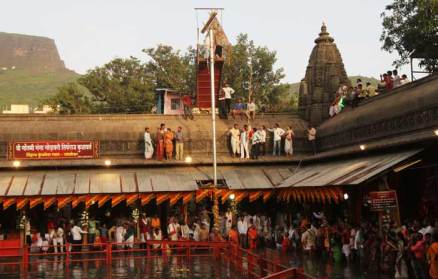
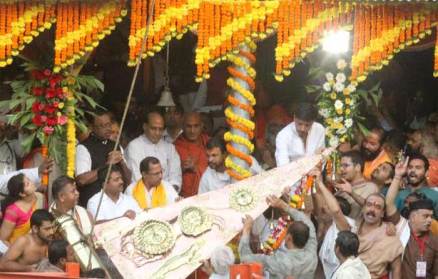
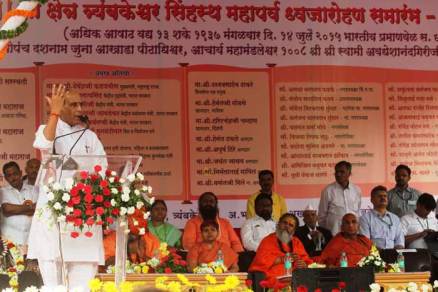
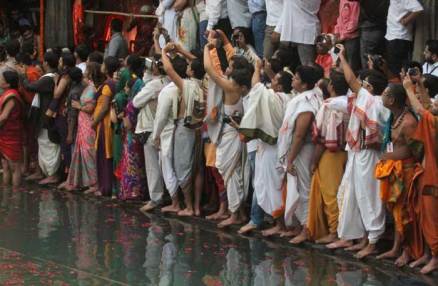
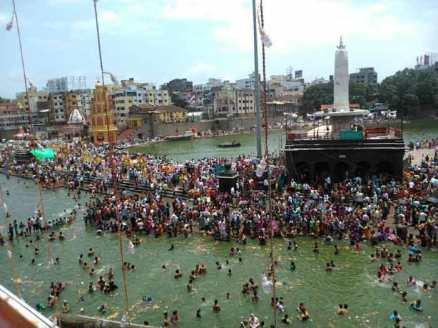
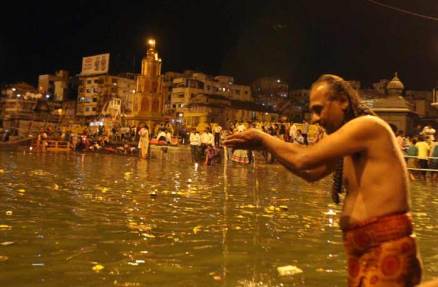
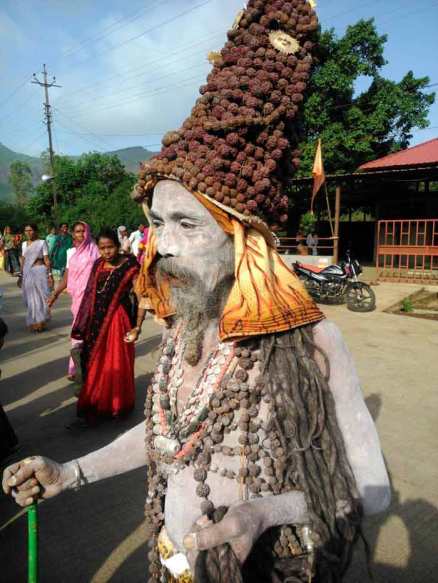


Dwaj arohan ( Flag hoisting) ceremony marked the formal commencement of the 2015 Kumbh Mela .

The religious ceremony was attended by Home Minister Rajnath Singh, State women and Child Welfare minister Pankaja Munde and the mahants of the the ‘akhadas .

Rajnath Singh addresses the crowd at Trimbakeshwar.





 | |||||||||||||||||||||||||||||||||||||||||||||||
Search Results
Nashik Kumbh Mela starts today - YouTube
www.youtube.com/watch?v=iieUjewwl5I6 hours ago - Uploaded by Abraham LauralynMajha Mahakumbh: Nashik: Dhwajarohan, Kumbhmela start from today. One of the ... The Nashik ...Simhastha Kumbh Mela Nashik 2015 | Seg 1 - YouTube
www.youtube.com/watch?v=32DY7D6JqygMay 12, 2015 - Uploaded by Saam TV MarathiWatch the special episode on Simhastha Kumbh Mela Nashik.Simhastha Kumbh Mela Nashik 2015 | Week 2 | Segment 1 ...
www.youtube.com/watch?v=jp7fHi79r4cMay 19, 2015 - Uploaded by Saam TV Marathiwww.saamtv.com Simhastha Kumbh Mela Nashik 2015 | Week 2 | Segment 1 Link : http://youtu.be/jp7fHi79r4c.Simhastha Kumbh Mela - YouTube
www.youtube.com/watch?v=SlYeaM4NqQQJan 23, 2015 - Uploaded by Tv9 MarathiNew Mobile Application on Simhastha Kumbh Mela 2015 by Sunil Khandbahale.. He arrange ...Ujjain Kumbh (Simhastha) Mela Yoga Seminar - YouTube
www.youtube.com/watch?v=i-PAvMH0l1o
Dec 1, 2014 - Uploaded by Pundit Radheshyam MishraUjjain Yoga Life Society International is organising 5th International Yoga Seminar in 2016 during Ujjain Kumbh.Simhastha Kumbh Mela Nashik 2015 | Seg 3 - YouTube
www.youtube.com/watch?v=IJfH96_PCysMay 12, 2015 - Uploaded by Saam TV MarathiWatch the special episode on Simhastha Kumbh Mela Nashik.Simhastha Kumbh Mela Nashik 2015 | Seg 2 - YouTube
www.youtube.com/watch?v=cn8DH8MqqBIMay 12, 2015 - Uploaded by Saam TV MarathiWatch the special episode on Simhastha Kumbh Mela Nashik.Simhastha Kumbh Mela Nashik 2015 | Week 2 | Segment 2 ...
www.youtube.com/watch?v=_jziH8wI1CIMay 19, 2015 - Uploaded by Saam TV Marathiwww.saamtv.com Simhastha Kumbh Mela Nashik 2015 | Week 2 | Segment 2 Link : http://youtu.be/_jziH8wI1CI.Simhastha Kumbh Mela Nashik 2015 |Episode 5 | Part 02 ...
www.youtube.com/watch?v=stFF0F-zwlQJun 25, 2015 - Uploaded by Saam TV MarathiSimhastha Kumbh Mela Nashik 2015 |Episode 5 | Part 02. Saam TV Marathi ...Simhastha Kumbh Mela Nashik 2015 | Episode 6 | Part 03 ...
www.youtube.com/watch?v=9j4YFufpi2cJun 25, 2015 - Uploaded by Saam TV MarathiSimhastha Kumbh Mela Nashik 2015 | Episode 6 | Part 03 ... Kings with Straw Mats - Yogis and Sadhus of the ...
Stay up to date on results for simhastha kumbh mela dhwajarohan.
Create alert
Showing results for simhastha kumbh mela dhwajarohan
Search instead for simhast kumbh mela dhwajarohan
Search instead for simhast kumbh mela dhwajarohan
Kumbh Mela Nashik-2015 - kumbhcampindia.com
Adwww.kumbhcampindia.com/Book Luxury Tents 20% Flat Discount Hurry - Offer valid till 15July
Search Results
Nashik Kumbh Mela 2015 begins - The Times of India
timesofindia.indiatimes.com/india/Nashik-Kumbh-Mela.../48063906.cms7 hours ago - The Nashik-Trimbakeshwar Simhastha Kumbh Mela was inaugurated by ... Performed 'puja' at 'Dhwajarohan Samaroh' in Nashik. My good ...
PM Modi's Kumbh invite sparks controversy | The Asian Age
www.asianage.com › Metros › MumbaiMay 17, 2015 - An invitation sent to Prime Minister Narendra Modi to attend theSimhastha Kumbh Mela 'dhwajarohan' or flag-hoisting ceremony has come ...
Main Bathing Dates for Nashik Kumbh Parva 2015 - Hindu ...
www.hindujagruti.org › Hinduism › Hinduism › Kumbh MelaUniqueness of 'Simhastha Parva' (Kumbha Mela) at Tryambakeshwar-Nashik ... Vadya P.13, Start of Simhastha Kumbha mela, Dhwajarohan, Ramkunda.
Nashik Kumbh Bathing dates - The Kumbh Mela
thekumbhmela.com/nashik-kumbh-mela-bathing-date.htmlinformation on important bathing dates for Nashik Kumbh Mela 2015.
[PDF]Kumbh Mela - Maharashtra Tourism
www.maharashtratourism.gov.in/HTML/.../Kumbha%20Mela.pdfKumbh. What is. The Kumbh Mela? It is an event beyond imagination. The kind that ..... Kumbh Mela. Flag hoisting ceremony (Dhwajarohan): The flag is more than ... emony can be done anytime during the Simhastha period, at any holy spot ...
Main Bathing Dates for Nashik Kumbh Parva 2015 | Kusum ...
m.speakingtree.in/.../main-bathing-dates-for-nashik-kumbh-parva-2015Jul 1, 2015 - The Kumbha Mela will be held at the Tryambakeshwar-Nashik from 14 July ... of Simhastha Kumbha mela, Dhwajarohan, Ramkunda19.8.2015, ...
Nashik Kumbh Mela starts today - YouTube
www.youtube.com/watch?v=iieUjewwl5I3 hours ago - Uploaded by Abraham LauralynMajha Mahakumbh: Nashik: Dhwajarohan, Kumbhmela start from today. One of the ... The Nashik ...Kumbh, Mela Latest & Top Breaking News
localnews.rediff.com/location#!kumbh-mela-location-Shrinks-IndiaAn invitation sent to Prime Minister Narendra Modi to attend the Simhastha Kumbh Mela 'dhwajarohan' or flag-hoisting ceremony has come under controversy.
Simhasta Kumbh Mela begins - The Tribune
www.tribuneindia.com/2003/20030731/main8.htmJul 31, 2003 - ... here to mark the beginning of the year-long Simhasta Kumbh mela. ... performed the “dhwaja rohan” (flag hoisting) ceremony at Ramkund on ...
Nashik: Kumbh Mela 2015 begins - India Hindi News
indiareckoner.net/2015/07/nashik-kumbh-mela-2015-begins/6 hours ago - The Nashik-Trimbakeshwar Simhastha Kumbh Mela was ... schedule · Majha Mahakumbh: Nashik: Dhwajarohan, Kumbhmela start from today ...
Searches related to simhastha kumbh mela dhwajarohan
Kharghar, Navi Mumbai, Maharashtra - From your Internet address - Use precise location













